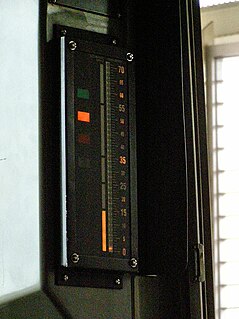
Railway signalling is a system used to direct railway traffic and keep trains clear of each other at all times. Trains move on fixed rails, making them uniquely susceptible to collision. This susceptibility is exacerbated by the enormous weight and momentum of a train, which makes it difficult to quickly stop when encountering an obstacle. In the UK, the Regulation of Railways Act 1889 introduced a series of requirements on matters such as the implementation of interlocked block signalling and other safety measures as a direct result of the Armagh rail disaster in that year.
The Train Protection & Warning System (TPWS) is a train protection system used throughout the two UK passenger main-line railway networks, and in Victoria, Australia.

A signal passed at danger (S.P.A.D.), known in the United States and Canada as running a red light, is an event on the railway where a train passes a stop signal without authority. Where colour light signals are in use, a S.P.A.D. occurs when a train passes a red signal without authority, and where semaphore signals are used, a S.P.A.D. occurs when a train passes a signal in the 'on' position without authority.

A balise is an electronic beacon or transponder placed between the rails of a railway as part of an automatic train protection (ATP) system. The French word balise is used to distinguish these beacons from other kinds of beacons.

The Automatic Warning System (AWS) was introduced in the 1950s in the United Kingdom to provide a train driver with an audible warning and visual reminder that they were approaching a distant signal at caution. Its operation was later extended to give warnings for;

GSM-R, Global System for Mobile Communications – Railway or GSM-Railway is an international wireless communications standard for railway communication and applications.

Cab signaling is a railway safety system that communicates track status and condition information to the cab, crew compartment or driver's compartment of a locomotive, railcar or multiple unit. The information is continually updated giving an easy to read display to the train driver or engine driver.

Radio Electronic Token Block is a system of railway signalling used in the United Kingdom. It is a development of the physical token system for controlling traffic on single lines. The system is slightly similar to North American Direct Traffic Control, which unlike RETB does not have a cab display unit.

The Cambrian Line is a railway that runs from Shrewsbury to Aberystwyth and Pwllheli, both on the west coast of Wales. The line from Dovey Junction to Pwllheli is sometimes called the Cambrian Coast Line.

Automatic train control (ATC) is a general class of train protection systems for railways that involves a speed control mechanism in response to external inputs. For example, a system could effect an emergency brake application if the driver does not react to a signal at danger. ATC systems tend to integrate various cab signalling technologies and they use more granular deceleration patterns in lieu of the rigid stops encountered with the older automatic train stop technology. ATC can also be used with automatic train operation (ATO) and is usually considered to be the safety-critical part of the system.

The European Train Control System (ETCS) is the signalling and control component of the European Rail Traffic Management System (ERTMS). It is a replacement for legacy train protection systems and designed to replace the many incompatible safety systems currently used by European railways. The standard was also adopted outside Europe and is an option for worldwide application. In technical terms it is a kind of positive train control (PTC).

Rule 55 was an operating rule which applied on British railways in the 19th and 20th centuries, and which was superseded by the modular rulebook following re-privatisation of the railways. It survives, very differently named: the driver of a train waiting at a signal on a running line must remind the signaller of its presence.
The European Rail Traffic Management System (ERTMS) is the system of standards for management and interoperation of signalling for railways by the European Union (EU). It is conducted by the European Union Agency for Railways (ERA) and is the organisational umbrella for the separately managed parts of
British Rail Telecommunications was created in 1992 by British Rail (BR). It was the largest private telecoms network in Britain, consisting of 17,000 route kilometres of fibre optic and copper cable which connected every major city and town in the country and provided links to continental Europe through the Channel Tunnel.
ERTMS Regional is a simplified and low-cost variant of the European Rail Traffic Management System suitable for train control on lines with low traffic volumes. It is intended to reduce the amount of lineside and equipment required, thus reducing costs, increasing reliability and improving safety for track workers.

KLUB is the name of the modern Russian train control systems. The abbreviation "КЛУБ" stands for "Комплексное локомотивное устройство безопасности", Integrated Train Protection System.

Ledbury Signal Box is a typical Great Western Railway traditional lever frame signal box which remains in daily use at Ledbury Station, Herefordshire, England on the railway line from Worcester to Hereford.
The European Rail Traffic Management System (ERTMS) is an initiative backed by the European Union to enhance cross-border interoperability and the procurement of signalling equipment by creating a single Europe-wide standard for train control and command systems.

A rail operating centre (ROC) is a building that houses all signallers, signalling equipment, ancillaries and operators for a specific region or route on the United Kingdom's main rail network. The ROC supplants the work of several other signal boxes which have thus become redundant.
Route knowledge is one of the core skills together with train handling and a full understanding of railway rules, which operating crew must possess in order to be able to drive a train safely.















